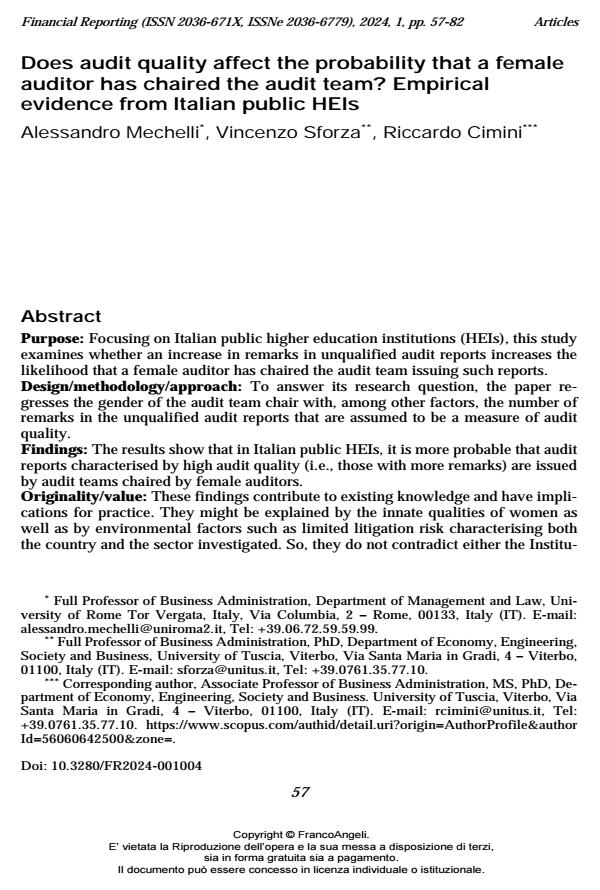Does audit quality affect the probability that a female auditor has chaired the audit team? Empirical evidence from Italian public HEIs
Journal title FINANCIAL REPORTING
Author/s Alessandro Mechelli, Vincenzo Sforza, Riccardo Cimini
Publishing Year 2024 Issue 2024/1
Language English Pages 26 P. 57-82 File size 167 KB
DOI 10.3280/FR2024-001004
DOI is like a bar code for intellectual property: to have more infomation
click here
Below, you can see the article first page
If you want to buy this article in PDF format, you can do it, following the instructions to buy download credits

FrancoAngeli is member of Publishers International Linking Association, Inc (PILA), a not-for-profit association which run the CrossRef service enabling links to and from online scholarly content.
Purpose: Focusing on Italian public higher education institutions (HEIs), this study examines whether an increase in remarks in unqualified audit reports increases the likelihood that a female auditor has chaired the audit team issuing such reports. Design/methodology/approach: To answer its research question, the paper re-gresses the gender of the audit team chair with, among other factors, the number of remarks in the unqualified audit reports that are assumed to be a measure of audit quality. Findings: The results show that in Italian public HEIs, it is more probable that au-dit reports characterised by high audit quality (i.e., those with more remarks) are issued by audit teams chaired by female auditors. Originality/value: These findings contribute to existing knowledge and have im-plications for practice. They might be explained by the innate qualities of women as well as by environmental factors such as limited litigation risk characterising both the country and the sector investigated. So, they do not contradict either the Institutional Logic perspective or the Ethics of Care Theory, according to which the environment and the aptitude to manage conflict differ between men and women.
Keywords: audit reports, auditor gender, audit quality
Jel codes: M42, H83
- Do female auditors affect accruals quality? A replication and extension of Ittonen, Vahamaa, and Vahamaa (2013) Camilla Ciappei, Claudia Frisenna, Diletta Vianello, in FINANCIAL REPORTING 2/2024 pp.77
DOI: 10.3280/FR2024-002004
Alessandro Mechelli, Vincenzo Sforza, Riccardo Cimini, Does audit quality affect the probability that a female auditor has chaired the audit team? Empirical evidence from Italian public HEIs in "FINANCIAL REPORTING" 1/2024, pp 57-82, DOI: 10.3280/FR2024-001004